by Wine Owners
Posted on 2018-04-10
Starting early, we hit the Monday-morning Bordeaux commuter congestion armed with laptops, phones and an excellent pain au chocolat. Day one launched us headlong into the Medoc grand crus, starting at Lafite, then moving through Mouton, Cos d'Estournel, Pontet-Canet, Calon-Segur, Montrose, finishing at Chateau Margaux.
©Jonathan Reeve / Wine Owners
Tongues still tingling from untamed tannins, we are now reviewing the day from the wine-free environs of our rented loft- conversion apartment. There is blue sky peeping through the skylights.
Three main themes emerged from today's en primeur 2017 tastings:
Cabernet Cornucopia
The most obvious pattern is that 2017 was clearly a Cabernet vintage in Pauillac and Saint-Estephe. Almost all of the wines we tried have a higher proportion of Cabernet Sauvignon in their blends than in 2016. The particular weather patterns of the 2017 growing season meant that Merlot was tricker in 2017, and Cabernet performed well. Lafite, Montrose and Calon-Segur particularly exemplified this - their wines glowing from the healthy Cabernet. The Calon tasting demonstrated this most clearly; comparing side-by-side the Marquis de Calon and the Calon-Segur (Cabernet was particularly higher in the latter) it became clear how a higher percentage of Cabernet has worked wonders in 2017. The Calon is fresher, brighter and more defined than the Marquis, has more-focused acidity, and will be by far the longer-lived wine.
A noteworthy exception to this pattern is the grand vin at Chateau Margaux, where the team are obviously very happy with their Merlot this year. In fact, their Merlot was apparently so good that it was used worthy of a greater dose in the grand vin this year - a move which brought production levels of the grand vin up to almost 2015 levels (impressive from the smaller 2017 vintage). This is an unusual moment of glory for Merlot, which is typically the ‘insurance policy' grape.
House Styles
One obvious pattern showing in day one's tastings was house styles. These are very much in evidence in 2017, and most obvious at the Mouton stable, where d'Armailhac, Petit Mouton, Mouton and Aile d'Argent all shared the house's exuberent, borderline-exotic richesse. This continues right down to the house's entry-level Baronarques brand from Limoux, which we were also warmly invited to taste. The four Cos d'Estournel wines also had a family feel about them, being clean, bright and focused, without being overly ‘new world'. The pattern was most pleasing, perhaps, at Montrose, where both the Dame de Montrose and the grand vin showed brilliantly, and shared a distinctive style; cool, fresh wines (yes, high Cabernet content) with lots of tightly wound potential, and a whiff of something herbal (along the lies of nettles and lavender) marking them out from the crowd.
©Jonathan Reeve / Wine Owners
Past and present
References to the past, as a means of promoting the present, were frequent in the presentations today.
Lafite's new director, Jean-Guillaume Prats (previously of Cos d'Estournel), pointed to technology as being significant in the quality of this 2017 vintage. Thirty years ago, he said, given the same vintage conditions, it would have been 'very tricky' to make a wine of such high quality as they have managed this vintage with both the Carruades and grand vin. Of course, his job is to say such things, but his demeanour was very real, honest and open. And the wines spoke for themselves; the Lafite was its usual elegant, impressive self even at this early stage in its life.
Also illustrating progress by pointing to the past was Thibault Pontalier of Chateau Margaux, who highlighted that the blend of Pavillon Rouge today is exactly the blend of the grand vin thirty years ago. A strong part of his reasoning for this was the ever- increasing quality of Cabernet Sauvignon that Margaux is able to produce, thanks to investment in technique and technology. This was in evidence for more than just the reds, however; Margaux's stunning Pavillon Blanc 2017 ended today with a refreshing flourish of beautifully concentrated, linear Sauvignon.
©Jonathan Reeve / Wine Owners
Comparing 2017 with 2016, the majority of wines from day one appear to be a notch less intense and refined than 2016. We're interested to see if this continues on the right bank.
Tomorrow we visit Nenin, Vieux Chateau Certan, Cheval Blanc, Gazin, La Couspade, Canon and Pavie. Watch this space tomorrow, for reflections on the right bank.
by Wine Owners
Posted on 2017-05-11
The tasting event in Westminster for the trade in early May provided an opportunity to re-taste a number of 2016 Bordeaux comparatively with their 2015 and 2014 equivalents.
The conclusions reinforce to a large extent the general impressions we formed in Bordeaux at the start of April, but the comparison also showed it’s not one size fits all.
Canon
Starting with the one wine tasted from the right bank, Canon 2016 is showing more aromatics than 2015, very silky, integrated tannins and is thicker-styled, with riper fruit. Canon 2015 showed greater intensity, with a stunningly pure mid-palate of ripe, sticky fruit, and a prolonged finish. Canon 2014 is more classically styled, with a cedar nose and liqueur-like mouth feel, this is lovely now and looks like much earlier drinking.
No doubt there are glorious wines from the Libournais in 2016, but both St Emillion and Pomerol do not conform to a vintage stereotype in these two vintages, and you will have preferences for individual wines from one or other year.
Smith Haut Lafitte
Jumping down to Pessac-Léognan, Smith Haut Lafitte (SML) 2016 is firm and properly dry, with crystalline fruit. Very intense and just on the right side of focus, with a very grippy, licorice finish. SML 2015 has a very energetic attack, sweet, refined tannins, a warm, fruity mid-palate and an aromatically spiced finish. SML 2014 was delicious but not in the same league as the other two vintages.
2015 was a stellar vintage in Pessac and Graves across the board. The same is not true of 2016 but SML showed (along with Haut Bailly, Chevalier and Carmes Haut Brion) that the best 16s are superlative and brilliantly architected for the long-term.
Rauzan Ségla
Rauzan Ségla 2016 is refined, with a liqueur-like mouth feel, and a hint of prunes. It’s less pure than Rauzan-Ségla 2015, with its fine nose, superbly energetic attack, refined mid palate and liquorice infused, fruit-driven finish. Rauzan-Ségla 2014 is dry, mid-weight, unforced and classic, with appealing grip, and a great, insistent finish.
Margaux was a star appellation of 2015, and this wine confirms how relatively disappointing the commune'’s wines are in 2016. They remain fine claret from a good vintage, but they miss out on the excitement of the ‘15s.
Pontet Canet
Our Pauillac representative of the comparative tasting stood out for its increasingly aromatic character, a factor that Justine Tesseron attributes to the growing influence that biodynamic farming is having on the fruit.
Pontet Canet 2015 was one of the most refined and silky examples of the appellation, yet today it just didn't cut it in the company of the glorious 2014 and deeply serious 2016. Pontet Canet 2016 displayed a fine nose, wonderfully textured fruit, a really firm mid-palate with bitter-edged fruit before sweetening into the long finish. Serious, long-haul stuff – and I suspect might become a legend 50 years hence. Pontet Canet 2014 is extremely aromatic, sweetly imbued with angelica flavouring, and with proper, grainy tannins on the finish.
Montrose
Montrose 2015 is delicious and aromatic: a fine showing for the vintage, yet seemed to lack a bit of structure. St Estephe in particular produced some of the best wines in a generation in 2016, and Montrose shows up that difference as does almost every wine from the appellation. Montrose 2016 is equally as expressive as 2015, but feels like a wine for the longer term, with more serious structure and vital freshness. What impresses here is the focus and elegance, which make this one of the stars of the vintage.
Picture: Wine Owners Ltd.
by Wine Owners
Posted on 2015-10-29
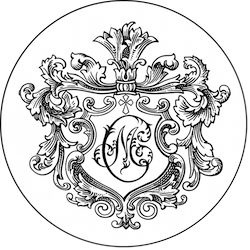
OWNER
Chateau Montrose
APPELLATION
Saint-Estephe
BLEND
Bordeaux Red Blend
AVERAGE SCORE
95/100
CRITICS REVIEW
'This is considered to be among the greatest vintages ever made in Montrose, right up with the 1929, 1945, 1947, 1959, 1961, 1989, 1990 and 2009. Harvest was October 15 to 17. The wine has really come on since I last tasted it, and it needs at least another 10 years of cellaring. The blend was 53% Cabernet Sauvignon, 37% Merlot, 9% Cabernet Franc and 1% Petit Verdot. The wine is opaque black/blue, with an incredible nose of blueberry and blackberry liqueur, with hints of incense, licorice, and acacia flowers. Tannins are incredibly sweet and very present. The wine is full-bodied, even massive, with great purity, depth and a finish that goes on close to a minute. This is a 50- to 75-year-old wine that will repay handsomely those with good aging genes.'
100 points - Robert Parker
View all scores & reviews
PRODUCER PROFILE
Area under vines 95 hectares
Soils deep, large size gravel with sand and a small amount of clay
Average age of the vines 40 years
Production 400 000 bottles a year
Planting density 9000 vines/ha
Ageing in 60% new oak barrels for 16 to 18 months
View full profile
MARKET PRICE
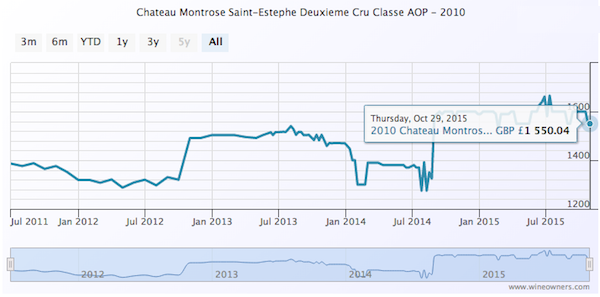
by Wine Owners
Posted on 2015-09-02
Chateau Pontet Canet - 2009
Region: Bordeaux (Medoc)
Appellation: Pauillac
Classification: Cinquieme Cru Classe
'An amazing wine in every sense, this classic, full-bodied Pauillac is the quintessential Pontet Canet from proprietor Alfred Tesseron, who continues to reduce yields and farms his vineyards biodynamically - a rarity in Bordeaux. Black as a moonless night, the 2009 Pontet Canet offers up notes of incense, graphite, smoke, licorice, creme de cassis and blackberries. A wine of irrefutable purity, laser-like precision, colossal weight and richness, and sensational freshness, this is a tour de force in winemaking that is capable of lasting 50 or more years. The tannins are elevated, but they are sweet and beautifully integrated as are the acidity, wood and alcohol (which must be in excess of 14%). This vineyard, which is situated on the high plateau of Pauillac adjacent to Mouton Rothschild, appears to have done everything perfectly in 2009. This cuvee should shut down in the cellar and re-open in a decade or more. Anticipated maturity: 2025-2075.' - 100 points RP
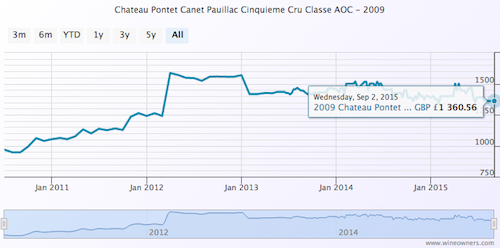
Chateau Cos d'Estournel - 2009
Region: Bordeaux (Medoc)
Appellation: Saint-Estephe
Classification: Deuxieme Cru Classe
'One of the greatest young wines I have ever tasted, the monumental 2009 Cos d'Estournel has lived up to its pre-bottling potential. A remarkable effort from winemaking guru Jean-Guillaume Prats and owner Michel Reybier, this blend of 65% Cabernet Sauvignon and the rest Merlot (33%) and a touch of Cabernet Franc (2%) was cropped at 33 hectoliters per hectare. It boasts an inky/black/purple color along with an extraordinary bouquet of white flowers interwoven with blackberry and blueberry liqueur, incense, charcoal and graphite. The wine hits the palate with extraordinary purity, balance and intensity as well as perfect equilibrium, and a seamless integration of tannin, acidity, wood and alcohol. An iconic wine as well as a remarkable achievement, it is the greatest Cos d'Estournel ever produced. It is approachable enough at present that one could appreciate it with several hours of decanting, but it will not hit its prime for a decade, and should age effortlessly for a half century.' - 100 points RP
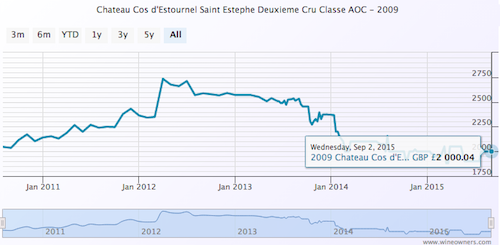
Chateau Montrose - 2005
Region: Bordeaux (Medoc)
Appellation: Saint-Estephe
Classification: Deuxieme Cru Classe
'In 2005, a very serious drought year stressed most vineyards in Bordeaux, which are all dry-farmed. The volume of rainfall was less than half the average of the previous 30 years. The clay subsoils at Montrose have always played a major role in not only dry years, but also in extremely hot ones, such as 2003, as they retain more moisture. The grapes were harvested between September 23 and October 9. This is a very powerful, full-bodied wine that is quite tannic, but the tannins are relatively velvety. The wine is rich, complex, majestic, multi-dimensional and also avoids any of the austerity that some 2005s possess. It has done quite well in its bottle evolution and should turn out to be a great Montrose, capable of lasting 30 to 50 years.' - 95 points RP
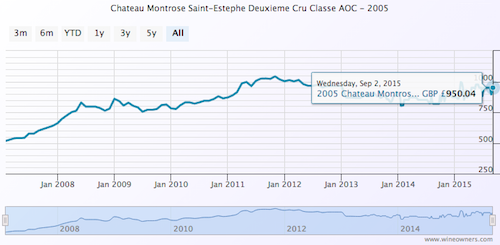
by Wine Owners
Posted on 2015-08-28
1/ Grand Puy Lacoste 2010 is a great wine. 4 years after release, the price is £100 off its opening price. GPL 2010 is surely now one of the buys of that wonderful vintage. Rated 95 points by Robert Parker this will be a magnificent drink in years to come. We would not be surprised to see this rerated 97 points in due course.
'An absolutely magnificent wine from this very popular estate, which sits well off the Route du Vin, just to the southwest of the town of Pauillac, its classic creme de cassis and floral notes are well-displayed. The wine possesses supple tannin, a full body, voluptuous character and a layered, impressively textured mouthfeel. This is a brilliant effort from Grand Puy Lacoste that can be drunk in 4-5 years or cellared for three decades or more.' RP 95.
- - -
2/ Montrose 2010 is another beauty, a perfect wine and less expensive than 2009, yet a seamless monument that is the equal of any of the First Growths. It’s hardly surprising this is a hot market: surely it’s only going to go one way from here?
'This is considered to be among the greatest vintages ever made in Montrose, right up with the 1929, 1945, 1947, 1959, 1961, 1989, 1990 and 2009. Harvest was October 15 to 17. The wine has really come on since I last tasted it, and it needs at least another 10 years of cellaring.' RP 100.
- - -
3/ Ducru Beaucaillou 2011 is interesting. It wasn’t so long ago that top new vintages of this super-second were releasing at well into 4 figures. The unfashionable 2011 vintage provides the opportunity to buy in for just £660 per case of 12.
Exchange activity is suggesting this is a buy as top-drawer drinking claret. The latest Parker score surely reflects the a period during which the wine has shut down. Once this wine starts to open up again, could there be the potential for it to be rerated in the 93-95 range in line with the en original primeur rating? Neal Martin’s rating is 92-94.
'The 2011 Ducru Beaucaillou (which normally represents 1/3 to ½ of the entire crop) possesses a dense ruby/purple color along with a beautiful nose of sweet creme de cassis, crushed rock and spring flower aromas. This rich, medium to full-bodied St.-Julien is among the most concentrated wines of the Medoc. Moderate tannin is sweet and well-integrated. This beauty will benefit from 3-5 years of cellaring and keep for two decades.' RP 92+.
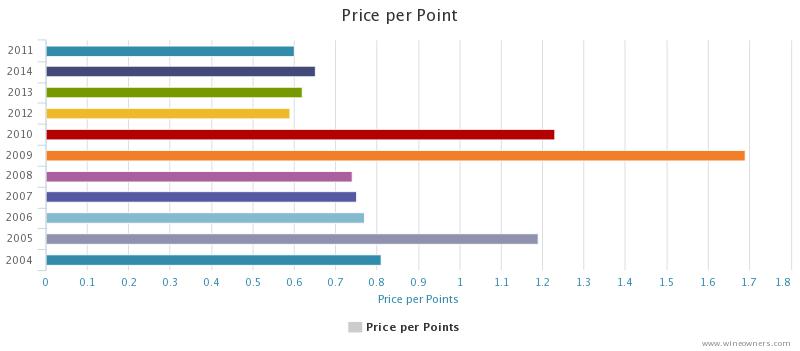
by Wine Owners
Posted on 2014-07-08
If a wine is from a first class vintage (serially dubbed ‘the vintage of the century’) and has scored a perfect or near perfect score, surely that wine is likely to give the greatest thrill; after all it’s considered the best that there is.
Or is it? If pleasure is what you're after, pulling a cork on highly–rated wine may be the most disappointing choice, especially if it’s from a relatively recent vintage.
Take the example of 1996 classed growth Medocs. Pontet Canet 1996 has impressive depth and purity that is currently held in check by a slowly receding tannic frame and enduringly fresh acidity. But one day it will surely be a very great wine.
Wines from so-called ‘off vintages’ (also known as restaurant vintages, shoulder vintages, an overshadowed by …. vintage) may give far superior current pleasure than its more illustrious, fêted siblings. Sticking with the Pontet Canet example, take your pick from 2002, 2004 or 2006 for wines which today deliver greater visceral pleasure; whether you favour Asian spiced, sweetly grained or delineated and pure fruit.
Switching to burgundy, surely great pinot noir doesn’t require the long wait of the finest red Bordeaux? Not so. Anyone who’s tasted the very best that 1999 has to offer will know how un-evolved, fruity and dense those wines still are. Sure, they impress with their texture and depth, but at the dinner table can disappoint with their primary-ness.
That peacock’s tail array of scent and flavour will one day burst out of the glass, seducing and beguiling the drinker. But today these wines merely provide waypoints to their future destination.
By contrast, the under-appreciated burgundy vintages of 1997, 1998 and 2000 provide some incredibly succulent current drinking, including Engel’s Vosne-Romanée Brûlées 1997, Ghislaine Barthod’s Chambolle-Musigny Les Cras 1998 and Denis Mortet’s Gevrey-Chambertin Champeaux 2000. There are countless others to pick from.
Thinking of arguably the greatest modern-era Italian, Roberto Conterno’s Monfortino, how can one compare the delicate 2002 with the blockbusting 1999? 2002 was a year in which most of sodden Piedmont suffered badly. Yet here is a sweet, perfectly poised wine showing soft red fruits and noble length. In contrast the 1999 is stunningly defined and intense, and a future monument for 10-20 years hence. But I’ll drink the 2002 now in preference.
What good is a cellar full of great vintages if you end up broaching so many of them in their infancy? Raise a glass for under-appreciated vintages. So often they will surprise and delight you, and may even win your best wines of the year awards!
Looking for ideas?
Leoville Barton 2002 - £450 (12x75cl) including duty and VAT
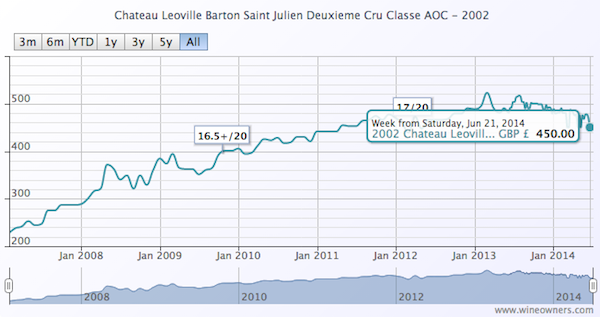
Montrose 2002 - £550 (12x75cl) ) including duty and VAT
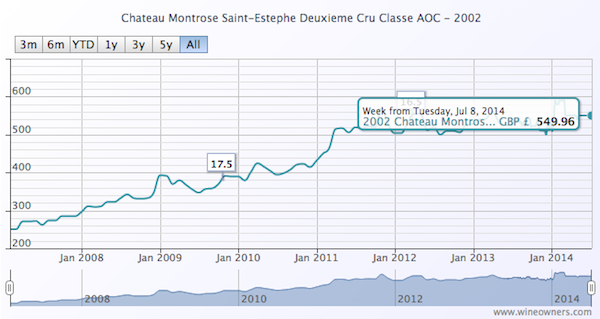
Malescot St. Exupery 2004 - £350 (12x75cl) In Bond
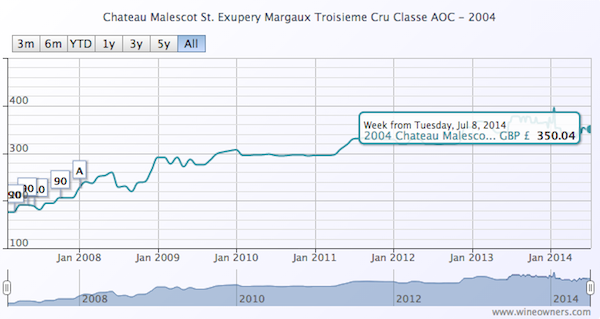
Louis Jadot Corton Les Greves Grand Cru 2001 - £150 (6x75cl) In Bond.
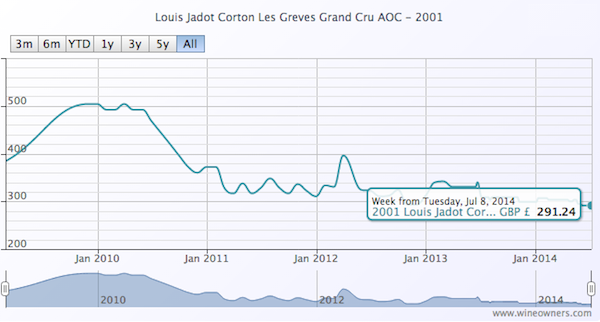
by Wine Owners
Posted on 2014-04-16
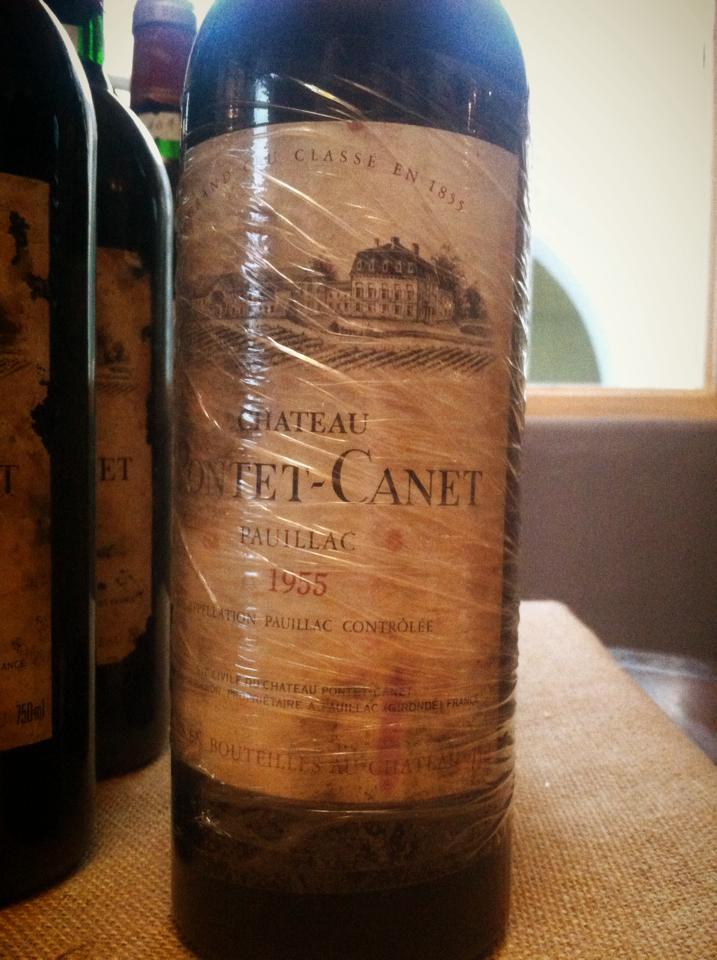
Nick Stephens is a respected wine expert with an international reputation as a critic and connoisseur. Nick was awarded the Prud'homme de la Jurade de Saint Emilion in 2007 for his work with the great chateaux and vineyards of that area. A devotee of the wines of Bordeaux, Nick has many years of insider knowledge and an array of chateaux owners, courtiers and negotiants that he does business with. Each year he visits Bordeaux for the En Primeur tastings held for the trade and reports back on the vintage in barrel. Also known as 'Wine Futures,' En Primeur is the opportunity to buy the wine before it is bottled (normally 18 – 24 months in the future) and released onto the market. Always hectic and often full of surprises the tastings are invaluable as they are the first indicator of the quality of the vintage. This year over 5000 wine merchants, brokers, critics, sommeliers and journalists from around 60 countries descended on Bordeaux for the event.
'This year Bordeaux En Primeur has attracted more comment and attention than expected, being even more agonised over than the boom years of 2010 and 2009. The 2013 vintage has been a trial for the Bordelais producers who have had to face severe weather conditions, reduced yields and rising production costs. If they had these difficulties twenty years ago most chateaux would not have been able to make a wine in such conditions. Thanks to advances in technology and increased expertise in vineyard management and in the chai wine was produced in 2013. The dry whites and sweet wines of Sauternes and Barsac are excellent but it is a different story for the reds. Overall they lack colour, complexity and depth. They will drink earlier than normal and 2013 is definitely not a speculators vintage.
Given that 2013 is a poor vintage for the Bordeaux red wines it is astonishing how much scrutiny they are commanding. Bordeaux has obviously not lost its appeal or its following.
But a spate of high priced years coupled with a run of mediocre vintages (2011, 2012 and 2013) means that wine enthusiasts and collectors need to look further afield. The best place to look for high quality Bordeaux reds is now in the past, in the back vintages of previous years and in particular 2008. In my opinion the 2008 wines are far superior in quality to more recent vintages and are more reasonably priced.
Over the past decade Bordeaux pricing hit two major price hikes and one minor. These occurred when good years were declared 'the vintage of the century'. The first was the 2005 vintage, the second with the 2009 and the third minor hike occurred with the 2010. The table below shows the release prices ex-negoce (to the trade) from a cross section of popular wines. At the time of writing the 2013 prices have only just started to be released. Pontet Canet, in an unprecedented move, released before the tastings had even begun.
|
Year
|
Margaux |
Parker Score |
Leoville Las Cases |
Parker Score |
Montrose |
Parker Score |
Pontet Canet |
Parker Score |
|
2004
|
96.00 |
93 |
50.00 |
93 |
31.80 |
91 |
24.50 |
90+
|
|
2005
|
460.00 |
98+ |
180.00 |
98 |
66.00 |
95 |
47.00 |
96+
|
|
2006
|
340.00 |
94+ |
125.00 |
95 |
51.00 |
94+ |
43.00 |
95+ |
|
2007
|
240.00 |
92 |
85.00 |
91+ |
45.00 |
91 |
43.00 |
91 - 94 |
| 2008 |
130.00 |
94 |
79.00 |
93 |
42.00 |
95 |
43.00 |
96
|
|
2009
|
550.00 |
99 |
216.00 |
98+ |
108.00 |
100 |
72.00 |
100 |
|
2010
|
600.00 |
99 |
192.00 |
96+ |
132.00 |
99 |
100.00 |
100
|
| 2011 |
360.00
|
94 - 96+ |
110.00 |
93 - 95+ |
72.00 |
91 - 93 |
66.00 |
93 - 95
|
| 2012 |
240.00 |
92 - 94 |
85.00 |
93 - 95+ |
57.60 |
92 - 94 |
60.00 |
91 - 94
|
| 2013 |
- |
- |
- |
- |
57.60 |
- |
60.00 |
-
|
As you can see from the table the 2008s hold their own in terms of quality with Parker scores being the equal or in some cases being higher, than those of 2007, 2011 and 2012 vintages. Scores for 2013 will not be released until Parker tastes the wines in June. A recent trade survey revealed that the industry itself believes the worst vintages in terms of quality regarding the First Growths are 2007 and 2013 whereas 2008 is considered the best. This is not surprising as the 2008 vintage represents good wine at a good price, despite the rise in value of some of the wines since their release. The wines are elegant, not over powering but with loads of fruit and well balanced tannins resulting in classic wines that can be drunk, savoured and enjoyed now or over the next three decades.
What happens to the En Primeur system itself if prices fail to drop for 2013 remains to be seen but savvy buyers can certainly find some lovely wines at good prices if they turn to overlooked vintages from decent years in the past.'
Nick Stephens
Prud'homme de la Jurade de Saint Emilion
Owner of www.bordeaux-undiscovered.co.uk and Fine Wine Merchants www.interestinwine.co.uk
by Wine Owners
Posted on 2013-11-15
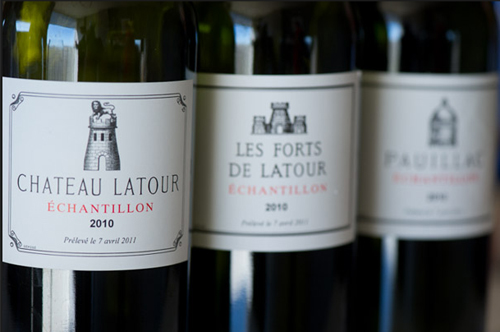
The 2009 Annual Bordeaux Tasting organised by The Institute of the Masters of Wine recently highlighted the high standard and homogeneity of Bordeaux 2009.
The best Medocs were beautifully perfumed, notably throughout the Graves, Margaux, and St. Julien. Where freshness was retained, the very ripe fruit lifted by fresh acidity, the wines were both easy to taste and delineated.
Examples that stood out were:
Pontet Canet with a refined, liqueur texture, fabulous confit yet crystalline, vivid fruit, and a velvety finish.
Leoville Barton was extremely pretty for a property that typically makes very structured long-term wines, exciting and fresh with wonderful aromatics.
Montrose was immense, and so confidently poised within its powerful structure.
Mission Haut Brion was truly fine; beautifully perfumed, noble fruit, dusty tannins in no way inhibiting a very long finish.
Sister property Haut Brion showed in a more structured vein, bright fruits, yeast and cedar on the nose, uplifting with a real sense of energy underlying the progression of flavours. Haut Brion was a beacon of how great 2009 can be when ripe fruit, acidity, structure and energy come together to create a unique, visceral experience. It also served to highlight how unctuous and relatively soft so many of the other wines in 2009 really are. And this isn't necessarily a good thing for the long term.
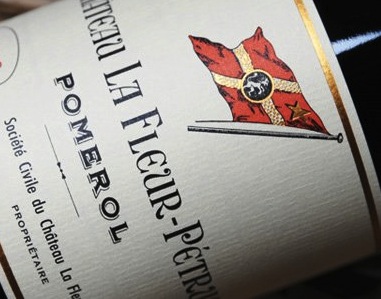
At a recent dinner tutored by Edouard Moueix where he showed La Fleur Petrus 2009 and 2010 side by side, the 2009 was unctuous and richly textured. The 2010 had more clearly delineated elements, showed as being far more complex, with wave after wave of nuanced flavours through an almost interminable finish.
Back in 2011, in the heat-wave of that Bordeaux spring, 2010 also showed brilliantly. Where wines were compared side by side, the 2010 vintage got my vote almost every time, including beauties from:
Calon Segur
Cheval Blanc
Haut Brion
Haut-Bailly
La Conseillante
L’Eglise-Clinet
La Mission Haut-Brion
Latour
Le Pin
Margaux
Montrose
Pichon Longueville Comtesse de Lalande
Rauzan Segla
Vieux Chateau Certan
So for me whilst the two vintages are both extraordinary; I prefer the definition, balance, complexity and enduring length of flavour so commonly found in the best 2010 red Bordeaux, which gets my vintage vote bar a few exceptions like Leoville Barton.

